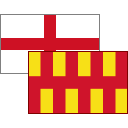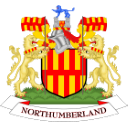
Haydon Bridge
Jun 2023
>
 Jun 2023+
Jun 2023+

hēg Anglian hay + denu valley + brig Old English bridge. Population - 2,184.
 UK
>
England
>
Northumberland
UK
>
England
>
Northumberland
Jun 2023+

For no other reason than you used to have to drive through here on your way out west from Newcastle on the A69 en route to a weekend in the Lakes. Too soon for a pit stop and too close on the way back home, SlyBob don't ever remember stopping.
Not that you would know it, these days, 15 years of campaigning followed by a public inquiry saw the place bypassed in 2009 so, finally, nice to meet you up close and personal Haydon.
They would have made hay here or hereabouts when it was all fields round here but it's doubtful that this is the original bridge over which it was carried.

That's a joke, of course, this used to carry 12,000 vehicles daily, HGVs included, before they built the bypass although it's still fairly busy today.
This snap was taken from the original, which inexplicably isn't shown, and has its foundations in the early 1300s with some repairs necessary over the centuries, you don't say.
They both span the River Tyne, the River Tyne you say? Surely you mean the River South Tyne, rising near Alston and flowing 40-or-so miles via Haydon before it meets the River North Tyne just north of Hexham.
That's where the River Tyne proper starts making it not much more than 20 miles long so shouldn't really qualify as one of the country's best-known rivers, really.
South and over the bridge and a pair of fleshpots for your pleasure. The Anchor Hotel is fancier than it looks but they don't do sandwiches so Oddfellows Coffee and some crisps it is.
They're housed in the old Oddfellows Hall, the meeting place of a mysterious bunch of Masonic-like, erm, fellows with their origins in the USA and of course it was men of the white variety only.

It's not thought that the cabal still congregates and the only mysterious thing today is how long do a couple of cappuccinos take?
That's slightly unfair, their fayre is far more extensive and a family who arrived earlier need feeding. It's unexpectedly hipster for a rural and bypassed Northumberland village and the avocados look smashing, by the way.
Back and over the bridge, still not shown, this stretch of whatever part of the Tyne it is has some significant width.

That's generally how settlements happen but it wasn't once all fields round here. Coal and lead mining have long had a presence in these parts so there was some smelting south of the bridge.
On the other side, the iron works that opened in the 1840s would have made this all run rusty red, probably.
One remnant of the small-scale revolutionary industry remains and that is the railway, which is also roughly where you would have found the iron works if your name was Queen Victoria.

Yes, despite its size, Haydon is a scheduled stop on the Tyne Valley Express or the regular service to and from Carlise if you'd rather.
A word of warning, though, don't even think about the last one back on a Saturday night. It's full of Cumbrians full of sauce after an afternoon and early evening out on the pop in Newcastle's Bigg Market, fact!
There are a couple of quirky distractions while you're this side of the river and what was once the main road through.
If you have time then somebody else who has plenty of it is D. Bell Watch & Clock Repairs. Not just repairs, though, Mr. George's Museum of Time, no less, although their opening times don't do Sundays.

Diana Bell has even written a range of children's books with a friendly clockmaker based on her dad George, lovely stuff.
Not all sustenance options have been exhausted and just round the corner at the Railway Hotel, there's bunny chow on the menu. Not those shot in the local fields but South African curry in a hollowed-out loaf, like you didn't know already.
Owner Calvin Lee Hood hails from Jo'burg, which is what he is allowed to call it, and changing direction of the business during and after you-know-what, the direction of the kitchen is now 6,000 miles south and it looks lekker bru.
Saying that, if you fancy something sweet post-Natal, head back over the bridge to Oddfellows whose brownies weren't half bad.
The disproportionate number of accommodation providers in the village is accounted for by this 84-mile walk from Wallsend to the Cumbrian Coast.
The path is roughly four miles north so you'll have to detour down for your dinner, as you will pretty much most days, actually, but your Northumbrian host will often arrange a lift back to the start in the morning.
It's doable in five-to-seven days depending on your determination and roughly follows the famous Roman wall or at least where the wall once was for large parts.
Meanwhile, back over the bridge, you'll find Oddfellows on Shaftoe Street, a helpful reverend who established a local charitable trust and not he of bonny, canny Geordie-lad fame.
The Fish & Chip shop next door, however, is on John Martin Street, as in he of John Martin fame. John Martin?
Born in Haydon Bridge to impoverished parents in 1789, the painting apprenticeship in Newcastle-upon-Tyne didn't quite work out and Martin ended up in London while still in his teens. He persevered with the pots to become 'the most popular painter of his day'. Still not heard of him?
His best-known works are best described as big, apocalyptic and Biblical and it's thought that The Destruction Of Sodom And Gomorrah was inspired by the iron works of Haydon Bridge.

That very nearly qualifies as an, erm, 'joke' but there's thought to be some truth in it, Martin no stranger to and retaining his ties with the Tyne Valley and Tyneside.
You can see this one hanging in Newcastle's Laing Art Gallery although most visitors think it's a photograph from last Saturday night in the Bigg Market.